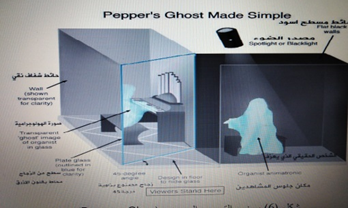The Utilization of Holograms in Modern Theatrical Productions
Abstract
 Abstract Views: 0
Abstract Views: 0
The production of a theatrical show necessitates the utilization of various materials, artistic elements, and techniques, in addition to the integration of technical and digital advancements. From this perspective, the director, who is responsible for the show's production, endeavors to leverage hologram technology to enhance and advance the show. This is achieved by incorporating fresh perspectives and innovative ideas, enhancing the aesthetic appeal, and captivating the audience with visually stunning elements. To do so, the current study aims to research the potential applications and opportunities for integrating holograms into modern production. Moreover, this study also aims to research three-dimensional holographic images as a modern theatrical technique in contemporary theatre. Additionally, this study explored the potential capabilities of holograms in modern theatrical performances, especially centralizing the theatrical production in the UK (Royal Shakespeare Theater-Stratford) for the preceding year of 2017. For this purpose, the study used the analytical research method and tools to analyze the show “The Strom” directed by Gregory Duran in 2017. A comprehensive set of results was obtained to conclude the study along with particular attention given to holography in the context of theatrical performance.
Downloads
References
O. Svelto and C. C. Hanna, Principles of Lasers. Springer, 2010.
D. Haley and O. Pratt, “Basic principles of lasers,” Anaesth. Intens. Care Med., vol. 18, no. 12, pp. 648–650, Dec. 2017, doi: https://doi.org/10.1016/j.mpaic.2017.10.001
W. S. Chang, Principles of Lasers and Optics. Cambridge University Press, 2005.
H. Ghuloum, “3D hologram technology in learning environment,” in Info. Sci. IT Edu. Conf., 2010, pp. 693–704.
H. Wen, “The influence of information technology on new media dance,” in Int. Conf. Big Data Analy. Cyber-Phy. Sys. Smart City, 2022, doi: https://doi.org/10.1007/978-981-16-7469-3_35
H. N. Larson and O. K. Larson, Scene Design in the American Theatre from 1915 to 1960. University of Arkansas Press, 1989.
A. Elmorshidy, “Holographic projection technology: The world is changing,” J. Telecommun., vol. 2, no. 2, May 2010, doi: https://doi.org/10.48550/arXiv.1006.0846
G. Y. Lee, J. Sung, and B. Lee, “Recent advances in metasurface hologram technologies. ETRI J., vol. 41, no. 1, pp. 10–22, Feb. 2019, doi: https://doi.org/10.4218/etrij.2018-0532
C. Slinger, C. Cameron, and M. Stanley, “Computer-Generated holography as a generic display technology,” Computer, vol. 38, no. 8, pp. 46–53, Aug. 2005, doi: https://doi.org/10.1109/MC.2005.260
T. Yoshida et al., “RePro3D: full-parallax 3D display with haptic feedback using retro-reflective projection technology,” 2011 IEEE Int. Symp. VR Innov., Singapore, 2011, pp. 49–54, doi: https://doi.org/10.1109/ISVRI.2011.5759601
R. Goldberg, “Performance art from futurism to the present,” in The Twentieth Century Performance Reader, Routledge, 2013, pp. 213¬–216.
N. Masura, Digital theatre: The making and meaning of live mediated performance, US & UK 1990-2020. Springer, 2020.
C. L. Evans, “An oral history of the first cyberfeminists.” VNSmatrix.com. https://vnsmatrix.net/wordpress/wp-content/uploads/an-oral-history-of-the-first-cyberfeminists-claire-l-evans-motherboard-vice-dec-11-2014-online-article.pdf
F. Keenan and S. Pauletto, “Design and evaluation of a digital theatre wind machine,” in Proc. Int. Conf. New Interf. Musical Exp., 2017, pp. 431–435.
A. S. Dundjerović, Live Digital Theatre: Interdisciplinary Performative Pedagogies. Taylor & Francis, 2023.

Copyright (c) 2024 Saad Abdul Karim Khayoun

This work is licensed under a Creative Commons Attribution 4.0 International License.

This work is licensed under a Creative Commons Attribution 4.0 International License. Authors retain copyright and grant the journal right of first publication with the work simultaneously licensed under a Creative Commons Attribution (CC-BY) 4.0 License that allows others to share the work with an acknowledgement of the work’s authorship and initial publication in this journal.





